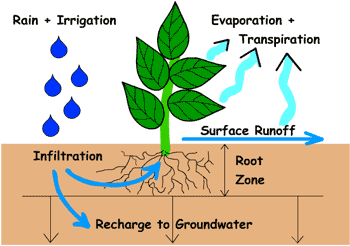THE NATURAL ENVIRONMENT
Geography 101
ToC
WATER
Cycle
Balance
Water In
Water Out
Soil
Classify
Soil Water Balance
|
|
BOX 1 |
In the previous section, we discussed how some of the rain falling on surfaces runs off (surface runoff) and the rest soaks into the ground (infiltration). This partitioning between runoff and infiltration turns out to be extremely important for many environmental issues, such as soil erosion and aquifer recharge, and is the object of intense research in many places in the world, including Hawai'i.
The fate of water added to the ground, either naturally by rainfall or artificially by irrigation, is determined in a shallow layer of soil at the surface. The surface properties of the soil determine the rate at which water can infiltrate. If the soil has been compacted, very little infiltration will take place and most of the water will run off. If, however, the soil is well aerated and porous, water can soak in rapidly and most of it will infiltrate.
Once water enters the soil by infiltration, it can follow one of two paths. Some of it will be sucked up by plant roots in the root zone and be transported to the leaves where it returns to the atmosphere through transpiration. Any water that evades plant roots and percolates below the root zone will continue descending until it reaches the water table and become recharge. Recharge simply means adding water to the groundwater aquifer. In general, a deep root zone means roots will absorb more water, leaving less to continue downward as recharge.
 |
|
Soil Water Balance Relationships |
Scientists who study water at the surface generally use a balance method to account for the various paths of water described above. Just as we studied the partitioning of energy using an Energy Balance (see Chapter 3 -> Balance), partitioning of surface water is studied using a Soil Water Balance. While you may never have heard of a soil water balance, I can assure you that millions of dollars have been spent studying it in Hawai'i.
The concept is pretty straightforward and can be summarized by the simple relationship:
Water In = Water Out + Change
Water In refers to all water added to the surface.
This includes all forms of precipitation, as well as
artificial watering such as irrigation. Water Out
refers to all water leaving the soil, either by direct evaporation to
the air, transpiration by plants, runoff over
the surface, or recharge to
the groundwater. In addition, the amount of water held
in the root zone, called soil moisture storage, continuously
changes. To summarize:
Rainfall + Irrigation = Evap&Transpiration + Runoff + Recharge + Change in Soil Moisture
Examples
Let's look at some typical examples of the soil water balance for different surfaces. Assume that 10 millimeters of rain fell on each surface and that agricultural land and housing areas had some irrigation.
Soil Water Balance |
Water In = |
Water Out + |
Change |
|||
(All values in millimeters) |
Rain |
Irrigation |
Evaporation and Transpiration |
Runoff |
Recharge |
Change in Soil Moisture |
agriculture |
10 |
2 |
6 |
3 |
2 |
1 |
forest |
10 |
0 |
4 |
0 |
5 |
1 |
exposed soil |
10 |
0 |
2 |
5 |
2 |
1 |
bare lava |
10 |
0 |
1 |
0 |
9 |
0 |
housing |
10 |
1 |
3 |
7 |
1 |
0 |
From a conservation perspective, the most important columns are Runoff and Recharge. In general, good conservation practice seeks to minimize runoff, because it causes soil erosion and wastes valuable water, and maximize recharge. Recharge provides a valuable reservoir of fresh water and helps maintain river flow during dry months. Both of these goals can be accomplished by increasing the soil's infiltration rate.
Notice that the highest runoff values are for agriculture, exposed soil, and housing and the highest recharge values are for forest, and bare lava. Look at the numbers for the Soil Water Balance terms and try to understand why this is true. In the next two sections we take a more detailed look at each term in the Soil Water Balance.